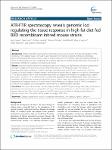ATR-FTIR spectroscopy reveals genomic loci regulating the tissue response in high fat diet fed BXD recombinant inbred mouse strains
Dogan, Ayca
Lasch, Peter
Neuschl, Christina
Millrose, Marion K.
Alberts, Rudi
Schughart, Klaus
Naumann, Dieter
Brockmann, Gudrun A.
Background: Obesity-associated organ-specific pathological states can be ensued from the dysregulation of the functions of the adipose tissues, liver and muscle. However, the influence of genetic differences underlying gross-compositional differences in these tissues is largely unknown. In the present study, the analytical method of ATR-FTIR spectroscopy has been combined with a genetic approach to identify genetic differences responsible for phenotypic alterations in adipose, liver and muscle tissues. Results: Mice from 29 BXD recombinant inbred mouse strains were put on high fat diet and gross-compositional changes in adipose, liver and muscle tissues were measured by ATR-FTIR spectroscopy. The analysis of genotype-phenotype correlations revealed significant quantitative trait loci (QTL) on chromosome 12 for the content of fat and collagen, collagen integrity, and the lipid to protein ratio in adipose tissue and on chromosome 17 for lipid to protein ratio in liver. Using gene expression and sequence information, we suggest Rsad2 (viperin) and Colec11 (collectin-11) on chromosome 12 as potential quantitative trait candidate genes. Rsad2 may act as a modulator of lipid droplet contents and lipid biosynthesis; Colec11 might play a role in apoptopic cell clearance and maintenance of adipose tissue. An increased level of Rsad2 transcripts in adipose tissue of DBA/2J compared to C57BL/6J mice suggests a cis-acting genetic variant leading to differential gene activation. Conclusion: The results demonstrate that the analytical method of ATR-FTIR spectroscopy effectively contributed to decompose the macromolecular composition of tissues that accumulate fat and to link this information with genetic determinants. The candidate genes in the QTL regions may contribute to obesity-related diseases in humans, in particular if the results can be verified in a bigger BXD cohort.
Dateien zu dieser Publikation
Keine Lizenzangabe

